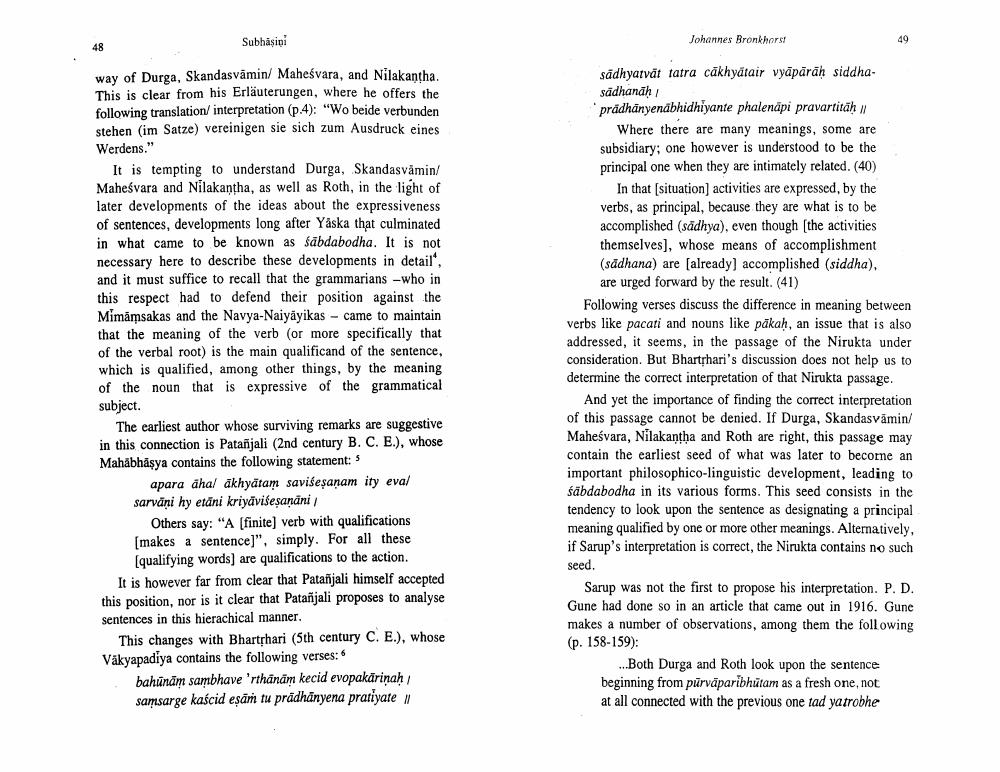Book Title: Yaska And Sentence Beginning Ofsabdabodha Author(s): Johannes Bronkhorst Publisher: Johannes Bronkhorst View full book textPage 3
________________ Subhasini Johannes Bronkhorst way of Durga, Skandasvamin/ Maheśvara, and Nilakantha. This is clear from his Erläuterungen, where he offers the following translation/interpretation (p.4): "Wo beide verbunden stehen (im Satze) vereinigen sie sich zum Ausdruck eines Werdens." It is tempting to understand Durga, Skandasvamin/ Maheśvara and Nilakantha, as well as Roth, in the light of later developments of the ideas about the expressiveness of sentences, developments long after Yaska that culminated in what came to be known as sābdabodha. It is not necessary here to describe these developments in detail, and it must suffice to recall that the grammarians - who in this respect had to defend their position against the Mimāmsakas and the Navya Naiyāyikas - came to maintain that the meaning of the verb (or more specifically that of the verbal root) is the main qualificand of the sentence, which is qualified, among other things, by the meaning of the noun that is expressive of the grammatical subject. The earliest author whose surviving remarks are suggestive in this connection is Patañjali (2nd century B. C. E.), whose Mahābhāşya contains the following statement: 5 apara ahal akhyātam saviseșanam ity eval sarväni hy etāni kriyaviseșanāni / Others say: "A (finite) verb with qualifications [makes a sentence]", simply. For all these [qualifying words) are qualifications to the action. It is however far from clear that Patanjali himself accepted this position, nor is it clear that Patañjali proposes to analyse sentences in this hierachical manner. This changes with Bharthari (5th century C. E.), whose Väkyapadiya contains the following verses: 6 bahūnām sambhave 'rthânām kecid evopakärinah samsarge kaścid eşām tu pradhânyena pratiyate / sādhyarvät tatra cākhyātair vyāpārāh siddhasādhanah prädhänyendbhidhiyante phalenäpi pravartitah Where there are many meanings, some are subsidiary: one however is understood to be the principal one when they are intimately related. (40) In that (situation activities are expressed by the verbs, as principal, because they are what is to be accomplished (sādhya), even though (the activities themselves), whose means of accomplishment (sadhana) are already) accomplished (siddha). are urged forward by the result. (41) Following verses discuss the difference in meaning between verbs like pacati and nouns like pākah, an issue that is also addressed, it seems, in the passage of the Nirukta under consideration. But Bharthari's discussion does not help us to determine the correct interpretation of that Nirukta passage. And yet the importance of finding the correct interpretation of this passage cannot be denied. If Durga, Skandasvāmin/ Maheśvara, Nilakantha and Roth are right, this passage may contain the earliest seed of what was later to become an important philosophico-linguistic development, leading to sabdabodha in its various forms. This seed consists in the tendency to look upon the sentence as designating a principal meaning qualified by one or more other meanings. Alternatively, if Sarup's interpretation is correct, the Nirukta contains no such seed. Sarup was not the first to propose his interpretation. P. D. Gune had done so in an article that came out in 1916. Gune makes a number of observations, among them the following (p. 158-159): ...Both Durga and Roth look upon the sentence beginning from pūrvāparibhūtam as a fresh one, not at all connected with the previous one tad yatrobhePage Navigation
1 2 3 4 5 6 7 8 9 10
